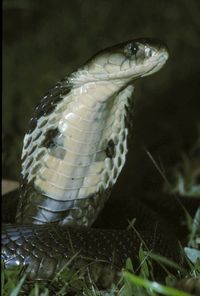Monocled cobra
| Monocled cobra | ||||||||||||||||||||
|---|---|---|---|---|---|---|---|---|---|---|---|---|---|---|---|---|---|---|---|---|
 Monocled cobra
| ||||||||||||||||||||
| Scientific classification | ||||||||||||||||||||
| ||||||||||||||||||||
| Binomial name | ||||||||||||||||||||
| Naja kaouthia Lesson, 1831[1][2] | ||||||||||||||||||||
| Synonyms | ||||||||||||||||||||
|
The Monocled cobra (Naja kaouthia), also commonly referred to as the Monocellate cobra or Thai cobra is a species of venomous cobra that belongs to the family Elapidae. It is a medium sized snake that is very common throughout Southeast Asia and the eastern regions of South Asia. This species causes more human fatalities than any other snake in Thailand.
Etymology and taxonomic history
The Monocled cobra was first described by French surgeon, naturalist, ornithologist and herpetologist René Primevère Lesson in 1831.[3] The generic name Naja is a Latinisation of the Sanskrit word nāgá (नाग) meaning "cobra". The specific epithet kaouthia is derived from the Bengali term "keauthia" which means "monocle".
Since it was first described by Lesson in 1831 several monocled cobras were described under different scientific names:
- In 1834, John Edward Gray published Thomas Hardwicke’s first illustration of a monocled cobra under the trinomial Naja tripudians var. fasciata.[4]
- In 1839, Thomas Cantor described a brownish monocled cobra with numerous faint yellow transverse stripes and a hood marked with a white ring under the binomial Naja larvata, found in Bombay, Calcutta and Assam.[5]
Several varieties of monocled cobras were described under the binomial Naja tripudians between 1895 and 1913.
- Naja tripudians var. scopinucha 1895
- Naja tripudians var. unicolor 1876
- Naja tripudians var. viridis 1913
- Naja tripudians var. sagittifera 1913
In 1940, Malcolm Arthur Smith classified the monocled cobra as a subspecies of the Indian cobra under the trinomial Naja naja kaouthia.[6]
- Naja kaouthia kaouthia – Deraniyagala, 1960
Description
The monocled cobra is medium to large in length, heavy bodied snake with long cervical ribs capable of expansion to form a hood when threatened. The body of this species is compressed dorsoventrally and sub-cylindrical posteriorly. Its head is elliptical, depressed, slightly distinct from the neck with a short, rounded snout and large nostrils. The eyes are medium in size with round pupils. Dorsal scales are smooth and strongly oblique. Most adults average between 1.1 m (3.61 ft) and 1.5 m (4.92 ft) in length but they can grow to a maximum length of 2.3 m (7.55 ft).[7][8] The colour pattern on the monocled cobra is highly variable. The ground colour is generally some shade of medium to dark brown or grey-brown, or blackish. Many specimens are uniform, others show some banding. The type of pattern varies geographically. Specimens may have a dorsal surface that may be yellow, brown, gray, or blackish, with or without ragged or clearly defined cross bands. It can be olivaceous or brownish to black above with or without a yellow or orange-colored, O-shaped mark on the hood. It has a black spot on the lower surface of the hood on either side, and one or two black cross-bars on the belly behind it. The rest of the belly is usually of the same color as the back, but paler. As age advances, it becomes paler, when the adult is brownish or olivaceous. The elongated nuchal ribs enable a cobra to expand the anterior of the neck into a "hood". A pair of fixed anterior fangs is present. The largest fang recorded measured 6.78 mm (0.678 cm). Fangs are moderately adapted for spitting. The monocled cobra has an O-shaped, or monocellate hood pattern. The hood mark of this species consists of light circle with a dark centre, but may sometimes be mask-shaped, with further dark spots in the light fields of the circle. In some specimens, the hood mark is connected to the light throat area. Occasionally, the hood mark may be "scrambled", making it impossible to assign it to one of the "standard" hood mark shapes, but this is rare in India.[9][10]
The ventral colouration is variable in this species. Most specimens have a clearly defined dark band behind the light throat, followed by a mottled light area, which becomes darker posteriorly until the entire ventral surface is dark. The underside of the tail is usually light, but often suffused with dark pigment.[10]
Scalation
They have 25 to 31 scales on the neck, 19 to 21, usually 21, on the body, and 17 or 15 on the front of the vent. They have 164 to 197 ventral scales and 43 to 58 subcaudal scales.[7]
Cited references
- ↑ Naja kaouthia (TSN 700628) at Integrated Taxonomic Information System. Accessed 15 June 2012.
- ↑ Naja kaouthia LESSON, 1831 at The Reptile Database. Accessed 15 June 2012.
- ↑ Lesson, R.P. 1831. Catalogue des Reptiles qui font partie d'une Collection zoologique recueille dans l'Inde continentale ou en Afrique, et apportée en France par M. Lamare-Piquot. Bulletin des Sciences Naturelles et de Géologie, Paris. 25 (2): 119-123
- ↑ Gray, J. E. (ed.) (1834) Cobra Capella. Illustrations of Indian zoology chiefly selected from the collection of Maj.-Gen. Hardwicke. Vol. II: Plate 78.
- ↑ Cantor, T. (1839) Naja larvata. Proceedings of the Zoological Society of London. Vol. VII: 32–33.
- ↑ Smith, M. A. (1940) Naja naja kaouthia. Records of the Indian Museum. Volume XLII: 485.
- ↑ 7.0 7.1 Smith, M. A. (1943). Naja naja kaouthia In: The Fauna of British India, Ceylon and Burma, Including the Whole of the Indo-Chinese Sub-Region. Reptilia and Amphibia. Volume III (Serpentes). Taylor and Francis, London. Pages 428–432.
- ↑ Chanhome, L., Cox, M. J., Vasaruchaponga, T., Chaiyabutra, N. Sitprija, V. (2011). Characterization of venomous snakes of Thailand. Asian Biomedicine 5 (3): 311–328.
- ↑ Whitaker, R. (1978). Common Indian Snakes. A Field Guide. Macmillan, New Delhi. XIV + 154 pp. ISBN 1403929556.
- ↑ 10.0 10.1 Wüster. Wolfgang. (1998). The Cobras of the Genus Naja in India. Hamadryad. Vol. 23, No. 1, 15-32 pp.